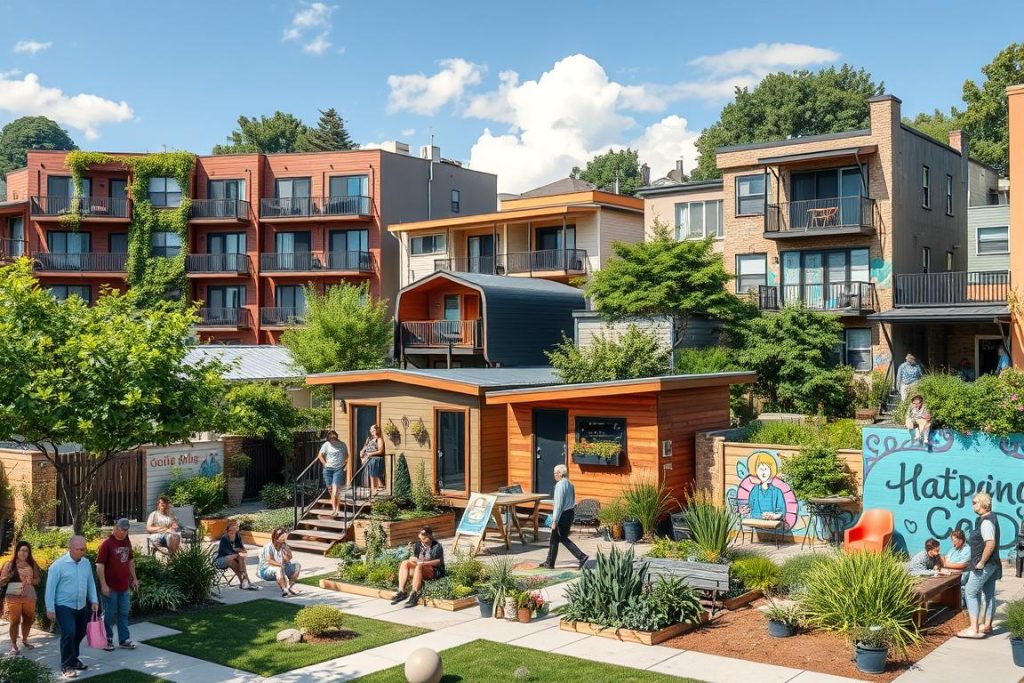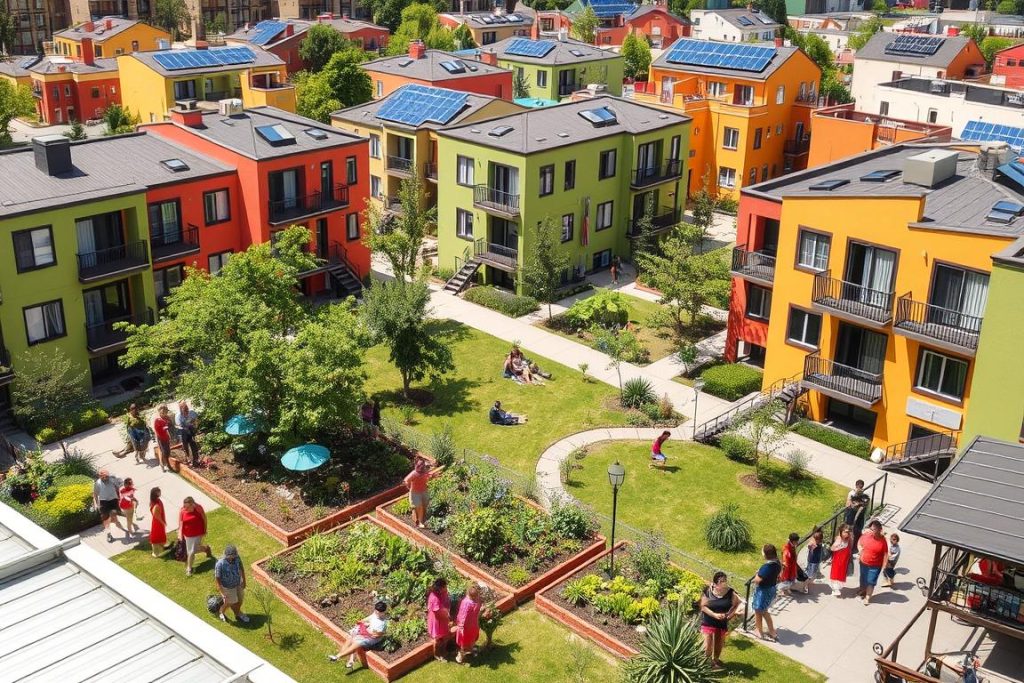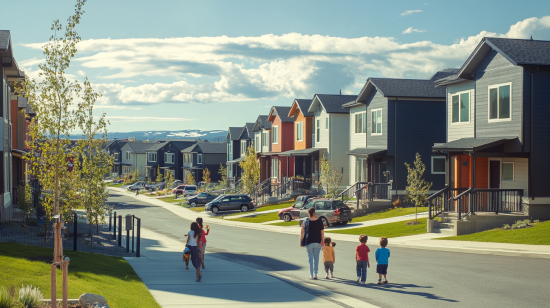The average rent in the United States jumped by 18% in the past five years. This rise is faster than general inflation rates. Now, the median rent has hit an all-time high of $1,745 a month as per Realtor.com’s June 2023 data. Despite a slight -1.0% drop from the previous year, it’s still too pricey for many. It demands an income of $62,820 a year to afford comfortably, which is way above the $57,200 median household income.
Facing these rent hikes, the initial costs can be overwhelming. Many landlords ask for first and last month’s rent plus a security deposit up front. This financial barrier stops many from renting. Additionally, almost 10 million Americans spend over half their income on rent. Given the limited public housing and assistance, looking into affordable housing is vital.
This guide offers tips from experts like Brynne Conroy of Femme Frugality and economic stats. It discusses creative ways to manage the skyrocketing rent. This includes trying out unique living situations for a more affordable life.

Key Takeaways
- Median rent in the U.S. is $1,745 per month, requiring an annual income of at least $62,820.
- Rent has increased by 18% over the last five years, outpacing inflation.
- 45% of federal housing assistance recipients are disabled or elderly.
- Exploring off-peak seasons and shared living spaces can reduce rental costs.
- Federally-funded housing developers are only required to allocate 5% for mobility accommodations.
What Is Affordable Housing?
Affordable housing is essential for those facing financial challenges. The Department of Housing and Urban Development (HUD) says if housing costs 30% or less of a family’s income, it’s affordable. This rule includes basic utilities and helps decide if a home is affordable for low-income families.

Definition and Criteria
To get affordable housing, families usually must earn below 50% of the Area Median Income (AMI). Over five million people in low-income households rely on the Housing Choice Voucher Program to help with rent. Still, seven out of ten of these families pay more than 30% of their income on rent. This is because there’s not enough federal support.
Current Affordable Housing Landscape
The affordable housing scene today faces big problems. For example, Rapid City, South Dakota, is short of nearly 3,500 affordable units. Government programs like the Low-Income Housing Tax Credit (LIHTC) aim to fix this by offering tax breaks to developers. However, Naturally Occurring Affordable Housing (NOAH) for middle-income families is under threat from market forces.
Local actions like tax alternatives (PILOT) and faster permits for developers help keep affordable housing available. When state money isn’t enough, these steps plus local housing trust funds make a difference. The PBV (Project-based Vouchers) program lets public agencies dedicate some vouchers to specific projects, helping as well.
Factors Contributing to High Rents
Many reasons exist for high rents, making it hard to find affordable homes. Rising property values, a lack of cheap rentals, and the high cost of buying a home push demand up. The National Association of Realtors (NAR) says home prices keep rising. Thus, people are looking at mobile homes, tiny houses, and shared living as other options.
Also, many affordable rentals have long wait lists due to high demand. Issues like criminal records or debts can make it harder to qualify. Groups like CommonBond understand these challenges and consider each person’s situation. This underlines the importance of being thorough with your application documents.
Exploring Alternative Living Arrangements
Dealing with high rents can be tough. Looking into other ways to live can help save money. Though people should aim to spend 30 percent of their income on housing, prices have gone up a lot. So, here are some good options:
Moving to a Cheaper Area
Moving to a cheaper place can really help, especially if you can work from anywhere. House prices have soared from over $200,000 in 2000 to more than $375,000 in 2020. By finding a less expensive area, you can save a lot and live better.
Living in an RV or Tiny Home
Living in a tiny house or RV is a great way to save money and travel. Tiny homes are cozy, cheap, and up to 399 sq ft. RVs give you freedom from regular houses and their costs. Both choices are great for saving money and living an adventure. Prefab and modular homes are similar and can save you money too.
Renting a Room or Co-Living Spaces
Renting a room or living with others can make housing cheaper. Co-living places offer affordable living without sacrificing quality. They support sharing and being eco-friendly. Choices like school buses turned homes or cool shipping container homes show the trend towards simple, cheaper living.
Learn more about alternative housing options to ease the stress of high rent.
- Tiny homes are simple and eco-friendly.
- Living together means sharing and caring.
- These lifestyle choices can reduce your carbon footprint and foster friendships.
Check out this table comparing different housing alternatives:
| Living Arrangement | Key Benefits |
|---|---|
| Moving to a Cheaper Area | Lower housing costs, chances for housing grants |
| Living in an RV | Save money, freedom to move |
| Tiny Home | Affordable, less harm to the planet |
| Co-Living Spaces | Share costs, make friends |
Conclusion
Many people find the cost of rent too high. This makes it essential to look for cheaper housing options. Affordable housing is crucial, especially for families making $30,000 to $50,000 a year. In the U.S., people earning minimum wage can’t afford a two-bedroom apartment. Also, if housing costs more than 30% of someone’s income, it’s considered too expensive.
Looking into affordable housing, we see that being creative with where and how we live is necessary. People are moving to places where living costs less. They are also choosing smaller homes like RVs or tiny houses and living with others in shared spaces. In Massachusetts, families with low incomes make up 80% of the median income. Those with moderate incomes earn between 80% and 120% of it.
Companies that renovate and build homes are very important. They make sure homes use space well and follow design and building rules. These companies work with others to help people find homes they can afford. Programs in Seattle and efforts by groups like Capitol Hill Housing show many ways to make housing more affordable. But, things like high building costs and strict rules make it hard. We need better planning and investment in public projects.
To deal with high rents, we need to think outside the box and keep trying to find answers. By looking at new types of homes, improving buildings, and helping each other, we can overcome these problems. There’s hope for finding affordable and sustainable ways to live.

